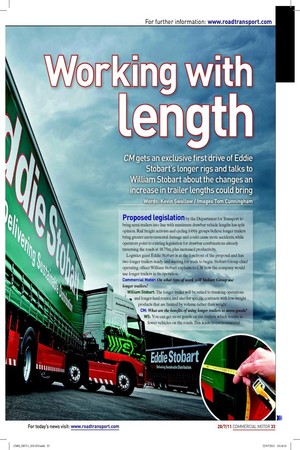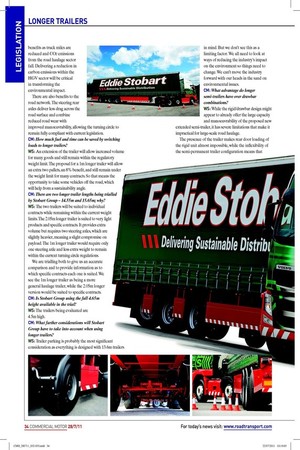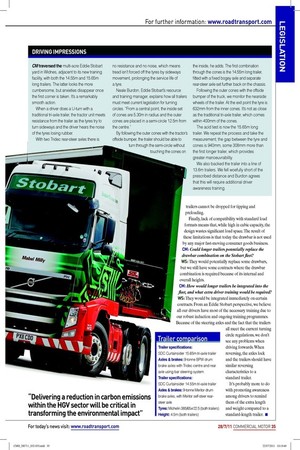orking with
Page 25

Page 26

Page 27

If you've noticed an error in this article please click here to report it so we can fix it.
en
CM gets an exclusive first drive of Eddie Stobart’s longer rigs and talks to William Stobart about the changes an increase in trailer lengths could bring
Words: Kevin Swallow / Images Tom Cunningham
Proposed legislation by the Department for Transport to
bring semi-trailers into line with maximum drawbar vehicle lengths has split opinion. Rail freight activists and cycling lobby groups believe longer trailers bring greater environmental damage and could cause more accidents, while operators point to existing legislation for drawbar combinations already traversing the roads at 18.75m, plus increased productivity.
Logistics giant Eddie Stobart is at the forefront of the proposal and has two longer trailers ready and waiting for trials to begin. Stobart Group chief operating oficer William Stobart explains to CM how the company would use longer trailers in its operation.
Commercial Motor: On what type of work will Stobart Group use longer trailers?
William Stobart: The longer trailer will be suited to trunking operations and longer-haul routes, and also for speciic contracts with low-weight products that are limited by volume rather than weight.
CM: What are the bene�ts of using longer trailers to move goods? WS: You can get more goods on the trailers, which results in fewer vehicles on the roads. This leads to environmental
beneits as truck miles are
reduced and CO2 emissions
from the road haulage sector fall. Delivering a reduction in carbon emissions within the HGV sector will be critical in transforming the environmental impact.
There are also beneits to the road network. The steering rear axles deliver less drag across the road surface and combine reduced road wear with improved manoeuvrability, allowing the turning circle to remain fully compliant with current legislation.
CM: How much fuel and time can be saved by switching loads to longer trailers?
WS: An extension of the trailer will allow increased volume
for many goods and still remain within the regulatory weight limit. The proposal for a 1m longer trailer will allow an extra two pallets, an 8% beneit, and still remain under the weight limit for many contracts. So that means the opportunity to take some vehicles off the road, which will help from a sustainability angle.
CM: There are two longer trailer lengths being trialled by Stobart Group – 14.55m and 15.65m; why?
WS: The two trailers will be suited to individual
contracts while remaining within the current weight limits. The 2.05m longer trailer is suited to very light products and speciic contracts. It provides extra volume but requires two steering axles, which are slightly heavier, meaning a slight compromise on payload. The 1m longer trailer would require only one steering axle and less extra weight to remain within the current turning circle regulations.
We are trialling both to give us an accurate comparison and to provide information as to which speciic contracts each one is suited. We see the 1m longer trailer as being a more general haulage trailer, while the 2.05m longer version would be suited to speciic contracts.
CM: Is Stobart Group using the full 4.65m height available in the trial?
WS: The trailers being evaluated are
4.5m high.
CM: What further considerations will Stobart Group have to take into account when using longer trailers?
WS: Trailer parking is probably the most signiicant
consideration as everything is designed with 13.6m trailers in mind. But we don’t see this as a limiting factor. We all need to look at ways of reducing the industry’s impact on the environment so things need to change. We can’t move the industry forward with our heads in the sand on environmental issues.
CM: What advantage do longer semi-trailers have over drawbar combinations?
WS: While the rigid/drawbar design might appear to already offer the large capacity and manoeuvrability of the proposed new extended semi-trailer, it has severe limitations that make it impractical for large-scale road haulage.
The presence of the trailer makes rear door loading of the rigid unit almost impossible, while the inlexibility of the semi-permanent trailer coniguration means that trailers cannot be dropped for tipping and preloading.
Finally, lack of compatibility with standard load formats means that, while high in cubic capacity, the design wastes signiicant load space. The result of these limitations is that today the drawbar is not used by any major fast-moving consumer goods business. CM: Could longer trailers potentially replace the drawbar combination on the Stobart leet?
WS: They would potentially replace some drawbars, but we still have some contracts where the drawbar combination is required because of its internal and overall heights.
CM: How would longer trailers be integrated into the leet, and what extra driver training would be required? WS: They would be integrated immediately on certain contracts. From an Eddie Stobart perspective, we believe all our drivers have most of the necessary training due to our robust induction and ongoing training programmes. Because of the steering axles and the fact that the trailers
all meet the current turning circle regulations, we don’t see any problems when driving forwards. When reversing, the axles lock and the trailers should have similar reversing characteristics to a standard trailer.
It’s probably more to do with promoting awareness among drivers to remind them of the extra length and weight compared to a standard-length trailer. ■











































